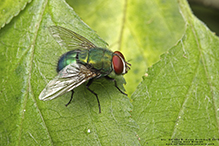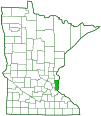Blue-green bottle fly
(Lucilia coeruleiviridis)
Conservation • Description • Habitat • Ecology • Distribution • Taxonomy
Conservation Status |
|||
| IUCN Red List | not listed |
||
| NatureServe | not listed |
||
| Minnesota | not listed |
||
Description
Blue-green bottle fly is a medium-sized blowfly. It occurs in the United States from New Hampshire to Iowa, south to Florida and New Mexico, and in adjacent Canadian provinces. It may be the most common blowfly (family Calliphoridae) in the southeast. There are no previous records of it in Minnesota.
Adults are ⅜″ to ½″ long, slightly larger than a house fly. Important identifying characteristics for this species include coloration, features of the face and antennae, and the number and placement of bristles on the thorax and abdomen. The abdomen and thorax are shiny metallic blue and green, usually with some copper color. The species epithet coeruleiviridis translates to “cerulean blue” and “green”. Both the thorax and the abdomen are covered with black hairs. Neither has golden hairs.
There are two large compound eyes at the side of the head and three small simple eyes (ocelli) in a triangle at the top of the head. The compound eyes are brown and bare, not covered with hairs. They do not meet at the top of the head on either sex. On the male they almost but do not quite touch. On the female they are broadly separated. The antennae have three segments. The second segment has a longitudinal groove (suture) on top. The third segment has a long bristle (arista) on the upper side. The arista is feather-like (plumose). The face is mostly white. The upper face (frons), corresponding to the forehead, is black. On the male it is very narrow, narrower than the first segment of the antenna. On the female it is less than one quarter the width of the head. The area between the frons and the compound eye (frontorbital plate) is white. There are long sensory organs (palps) attached to the mouth. The palps are entirely orange or yellow, not dark at the tip. The protruding mouthpart (proboscis) is not slender and piercing.
The thorax has three segments. It is covered with numerous short, black, bristle-like hairs (setae), and several parallel rows of long black bristles. Each segment has four principal exoskeletal plates, one above, one below, and one on each side. The upper (dorsal) plates, from front to rear, are the prescutum, scutum, and scutellum. There is a distinct groove (transverse suture) across the thorax separating the prescutum and scutum. On the scutum, the two rows of bristles closest to the middle each have just 2 bristles, not 3. On each side, the small elongated triangular plate below the prescutum (notopleuron) has just 2 long bristles. The plate just above the base of the hind leg (hypopleuron) has bristles.
The third segment of the abdomen has uniformly small bristles on the margin.
The wings are mostly clear but with dark veins and a light, smoky-brown tint near the base. At the base of each wing there are two large rounded lobes (calypters) that cover the balancing organs (halteres). The media (M) vein is sharply bent. The first posterior cell (R5) is narrowed but open at the wing tip.
The legs are black.
Size
Total length: ⅜″ to ½″
Similar Species
Habitat
Ecology
Season
Three or four generations per year. Spring through fall.
Behavior
The wings are held out at an angle when at rest, not almost parallel to the body.
Life Cycle
Larva Food/Hosts
Partially decomposed animal tissue and dung.
Adult Food
Distribution |
||
|
Sources Biodiversity occurrence data published by: Minnesota Biodiversity Atlas (accessed through the Minnesota Biodiversity Atlas Portal, bellatlas.umn.edu, 9/30/2025). |
|
| 9/30/2025 | ||
Occurrence |
||
|
||
Taxonomy
Order
Suborder
Brachycera
Infraorder
Cyclorrhapha
Zoosection
Schizophora
Zoosubsection
Calyptratae (Calyptrate Flies)
Superfamily
Oestroidea (Bot Flies, Blow Flies, and Allies)
Family
Calliphoridae (blow flies)
Subfamily
Luciliinae
Tribe
Luciliini
Genus
Lucilia (greenbottle flies)
Genus
This species was formerly placed in the genus Phaenicia.
Subordinate Taxa
Synonyms
Lucilia australis
Lucilia caeruleiviridis
Lucilia oculata
Phaenicia coeruleiviridis
Common Names
blue-green bottle fly
Glossary
Arista
A large bristle on the upper side of the third segment of the antenna of a fly. Plural: aristae.
Calypter
On flies: one of two small membranous lobes at the base of the forewing that covers the haltere.
Frons
The upper front part of an insect’s face, roughly corresponding to the forehead.
Halteres
In flies: a pair of knob-like structures on the thorax representing hind wings that are used for balance.
Ocellus
Simple eye; an eye with a single lens. Plural: ocelli.
Palp
Short for pedipalp. A segmented, finger-like process of an arthropod; one is attached to each maxilla and two are attached to the labium. They function as sense organs in spiders and insects, and as weapons in scorpions. Plural: palpi or palps.
Proboscis
The tube-like protruding mouthpart(s) of a sucking insect.
Scutellum
The exoskeletal plate covering the rearward (posterior) part of the middle segment of the thorax in some insects. In Coleoptera, Hemiptera, and Homoptera, the dorsal, often triangular plate behind the pronotum and between the bases of the front wings. In Diptera, the exoskeletal plate between the abdomen and the thorax.
Scutum
The forward (anterior) portion of the middle segment of the thorax (mesonotum) in insects and some arachnids.
Seta
A stiff, hair-like process on the outer surface of an organism. In Lepidoptera: A usually rigid bristle- or hair-like outgrowth used to sense touch. In mosses: The stalk supporting a spore-bearing capsule and supplying it with nutrients. Plural: setae. Adjective: setose.
Visitor Photos
Share your photo of this insect.
This button not working for you?
Simply email us at info@MinnesotaSeasons.com.
Attach one or more photos and, if you like, a caption.
|
||
Alfredo Colon |
 |
MinnesotaSeasons.com Photos
|

Slideshows

Visitor Videos
Share your video of this insect.
This button not working for you?
Simply email us at info@MinnesotaSeasons.com.
Attach a video, a YouTube link, or a cloud storage link.
Other Videos



